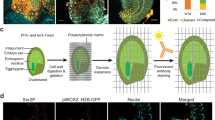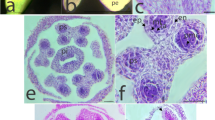Abstract
Key message
Extended antipodal life-span.
Abstract
The female gametophyte of most flowering plants forms four cell types after cellularization, namely synergid cell, egg cell, central cell and antipodal cell. Of these, only the antipodal cells have no established functions, and it has been proposed that in many plants including Arabidopsis, the antipodal cells undergo programmed cell death during embryo sac maturation and prior to fertilization. Here, we examined the expression of female gametophyte-specific fluorescent reporters in mature embryo sacs of Arabidopsis, and in developing seeds shortly after fertilization. We observed expression of the fluorescence from the reporter genes in the three antipodal cells in the mature stage embryo sac, and continuing through the early syncytial endosperm stages. These observations suggest that rather than undergoing programmed cell death and degenerating at the mature stage of female gametophyte as previously supposed, the antipodal cells in Arabidopsis persist beyond fertilization, even when the other cell types are no longer present. The results support the concept that the Arabidopsis female gametophyte at maturity should be considered to be composed of seven cells and four cell types, rather than the previously prevailing view of four cells and three cell types.



Similar content being viewed by others
References
Christensen CA, King EJ, Jordan JR, Drews GN (1997) Megagametogenesis in Arabidopsis wild type and the Gf mutant. Sex Plant Reprod 10:49–64
Diboll AG, Larson DA (1966) An electron microscopic study of the mature megagametophyte in Zea mays. Am J Bot 53:391–402
Dong J, Yang HY (1989) An ultrastructural study of embryo sac in Oryza sativa L. Acta Bot Sin 31:81–88
Drews GN, Koltunow AM (2011) The female gametophyte. The Arabidopsis Book 9:e0155. doi:10.1199/tab.0155
Heydlauff J, Gross-Hardt R (2014) Love is a battlefield: programmed cell death during fertilization. J Exp Bot 65:1323–1330
Higashiyama T, Kuroiwa H, Kawano S, Kuroiwa T (1998) Guidance in vitro of the pollen tube to the naked embryo sac of Torenia fournieri. Plant Cell 10:2019–2031
Kägi C, Baumann N, Nielsen N, Stierhof Y, Groß-Hardt R (2010) The gametic central cell of Arabidopsis determines the lifespan of adjacent accessory cells. PNAS 107:22350–22355
Lawit SJ, Chamberlin MA, Agee A, Caswell ES, Albertsen MC (2013) Transgenic manipulation of plant embryo sacs tracked through cell-type-specific fluorescent markers: cell labeling, cell ablation, and adventitious embryos. Plant Reprod 26:125–137
Leshem Y, Johnson C, Wuest SE, Song X, Ngo QA, Grossniklaus U, Sundaresan V (2013) Pollen tube entry into the synergid cell of Arabidopsis is observed at a site distinct from the filiform apparatus. Plant Reprod 26:93–99
Liu CM, Meinke DW (1998) The titan mutants of Arabidopsis are disrupted in mitosis and cell cycle control during seed development. Plant J 16:21–31
Ma H, Sundaresan V (2010) Development of flowering plant gametophytes. Curr Top Dev Biol 91:379–412
Maeda E, Miyake H (1997) Ultrastructure of antipodal cells of rice (Oryza sativa) before anthesis with special reference to concentric configuration of endoplasmic reticula. Jpn J Crop Sci 66:488–496
Maheshwari P (1950) An introduction to the embryology of angiosperms. McGraw-Hill, New York
Moll C, von Lyncker L, Zimmermann S, Kagi C, Baumann N, Twell D, Grossniklaus U, Gross-Hardt R (2008) CLO/GFA1 and ATO are novel regulators of gametic cell fate in plants. Plant J 56:913–921
Murgia M, Huang BQ, Tucker SC, Musgrave ME (1993) Embryo sac lacking antipodal cells in Arabidopsis thaliana (Brassicaceae). Am J Bot 80:824–838
Pennell RI, Lamb C (1997) Programmed cell death in plants. Plant Cell 9:1157–1168
Randolph LF (1936) Developmental morphology of the caryopsis in maize. J Agric Res 53:881–916
Ravi M, Chan SW (2010) Haploid plants produced by centromere-mediated genome elimination. Nature 464:615–618
Rotman N, Durbarry A, Wardle A, Yang WC, Chaboud A, Faure JE, Berger F, Twell D (2005) A novel class of MYB factors controls sperm-cell formation in plants. Curr Biol 15:244–248
Schneitz K, Hulskamp M, Pruitt RE (1995) Wild-type ovule development in Arabidopsis thaliana: a light microscope study of cleared whole-mount tissue. Plant J 7:731–749
Sprunck S, Gross-Hardt R (2011) Nuclear behavior, cell polarity, and cell specification in the female gametophyte. Sex Plant Reprod 24:123–136
Steffen JG, Kang IH, Macfarlane J, Drews GN (2007) Identification of genes expressed in the Arabidopsis female gametophyte. Plant J 51:281–292
Sundaresan V, Alandete-Saez M (2010) Pattern formation in miniature: the female gametophyte of flowering plants. Development 137:179–189
Wu JJ, Peng XB, Li WW, He R, Xin HP, Sun MX (2012) Mitochondrial GCD1 dysfunction reveals reciprocal cell-to-cell signaling during the maturation of Arabidopsis female gametes. Dev Cell 23:1043–1058
Yadegari R, Drews GN (2004) Female gametophyte development. Plant Cell 16(Suppl):S133–S141
Acknowledgments
The authors are grateful to Wei-Cai Yang, Institute of Genetics and Development, for the CDC123::H2B:YFP fusion, to Maruthachalam Ravi for the CENH3::GFP fusion, and to Scott Russell (U. Oklahoma), Marissa Simon and Shai Lawit (Pioneer), and the members of the Sundaresan and Gasser laboratories at the University of California-Davis for helpful comments and suggestions. This research was supported by a National Science Foundation Grant IOS-1051951 to V.S. X.S. was partially supported by the Elsie Taylor Stocking Memorial Research Fellowship.
Conflict of interest
The authors declare that no conflict of interest exists.
Author information
Authors and Affiliations
Corresponding author
Additional information
Communicated by Weicai Yang.
Electronic supplementary material
Below is the link to the electronic supplementary material.
Rights and permissions
About this article
Cite this article
Song, X., Yuan, L. & Sundaresan, V. Antipodal cells persist through fertilization in the female gametophyte of Arabidopsis . Plant Reprod 27, 197–203 (2014). https://doi.org/10.1007/s00497-014-0251-1
Received:
Accepted:
Published:
Issue Date:
DOI: https://doi.org/10.1007/s00497-014-0251-1




